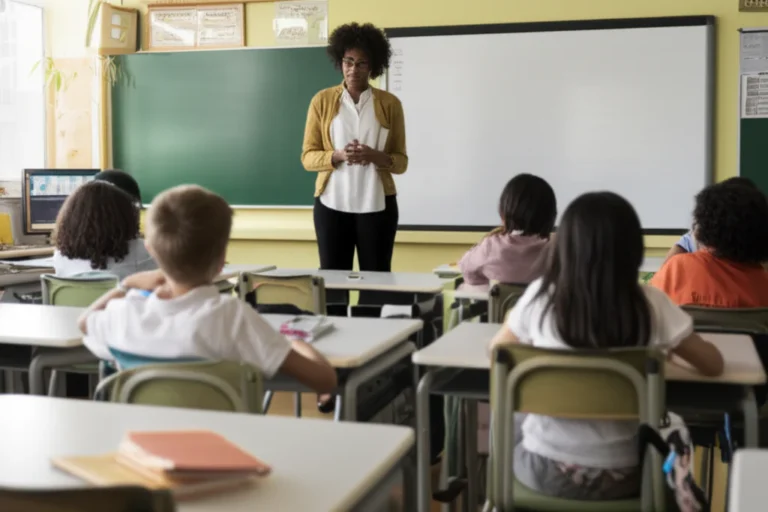Support our educational content for free when you buy through links on our site. Learn more
9 Proven Ways to Establish Clear Classroom Rules in 2025 🎯
Imagine walking into a classroom where every student knows exactly what’s expected—no confusion, no disruptions, just smooth sailing through lessons. Sounds like a dream, right? Well, it’s not! Establishing clear expectations and rules is the secret sauce that transforms chaotic classrooms into hubs of learning and respect. But how exactly do you craft these rules so they stick and foster a positive culture?
In this article, we’ll unpack 9 proven strategies that go beyond the usual “don’t talk out of turn” mantra. From involving students in rule-making to leveraging tech tools like ClassDojo, and even handling those tricky moments when expectations aren’t met, we cover it all. Plus, we’ll share evidence-based interventions and insider tips from our Teacher Strategies™ experts that you won’t want to miss. Ready to master the art of clear classroom expectations? Let’s dive in!
Key Takeaways
- Keep rules simple, positive, and limited to 3-5 core expectations to maximize clarity and compliance.
- Involve students and parents in creating and reinforcing classroom norms for greater buy-in.
- Use visual aids and technology like ClassDojo and Kickboard to communicate and track behavior effectively.
- Implement evidence-based interventions such as PBIS and restorative practices to support diverse student needs.
- Consistent modeling, teaching, and reinforcement of rules build a respectful and productive classroom culture.
- When challenges arise, respond with calm, logical consequences and be open to adjusting rules collaboratively.
Ready to equip your classroom with the best tools?
- 👉 Shop Classroom Management Tools on: Amazon | Walmart | ClassDojo Official
Unlock the full guide below and transform your classroom into a well-oiled learning machine! 🚀
Table of Contents
- ⚡️ Quick Tips and Facts on Setting Classroom Expectations
- 📚 The Evolution of Classroom Rules: Why Clear Expectations Matter
- 1. Crafting Essential Classroom Rules and Expectations That Stick
- 2. Proven Strategies to Teach and Reinforce Acceptable Classroom Behavior
- 3. Building a Positive Classroom Culture Through Clear Expectations
- 4. Using Visual Aids and Technology to Communicate Classroom Rules Effectively
- 5. Collaborating with Students and Parents to Establish Shared Expectations
- 6. Evidence-Based Behavior Interventions for Classroom Management Success
- 7. Tailoring Behavior Interventions: A Toolkit for School Teams and District Leaders
- 8. Handling Challenges: What to Do When Expectations Are Not Met
- 9. Monitoring and Adjusting Classroom Rules for Continuous Improvement
- 🔍 Conclusion: Mastering Clear Expectations for a Thriving Classroom
- 🔗 Recommended Links for Further Reading and Resources
- ❓ Frequently Asked Questions About Classroom Expectations
- 📑 Reference Links and Credible Sources
⚡️ Quick Tips and Facts on Setting Classroom Expectations
Welcome to the ultimate guide on how to establish clear expectations and rules in your classroom! 🎉 At Teacher Strategies™, we’ve seen firsthand how clarity and consistency can transform chaotic classrooms into thriving learning communities. Before we dive deep, here are some quick nuggets to get you started:
- ✅ Keep rules simple and positive: Use phrases like “Respect others” instead of “Don’t be rude.”
- ✅ Limit the number of rules: Aim for 3-5 core expectations to avoid overwhelming students.
- ✅ Involve students in rule-making: Ownership boosts compliance and respect.
- ✅ Explain the “why”: When students understand the purpose behind rules, they’re more likely to follow them.
- ✅ Model the behavior: Teachers must walk the talk to set the tone.
- ✅ Post rules visibly: Use posters, charts, or digital displays for constant reminders.
- ✅ Consistent reinforcement: Praise good behavior and address infractions fairly and promptly.
Did you know? According to the American Psychological Association, classrooms with clear behavioral expectations see up to 30% fewer disruptions and improved academic engagement (APA Source).
Curious about the best way to craft those rules? Keep reading — we’re just getting started! And if you want a quick visual overview, check out the featured video embedded above.
📚 The Evolution of Classroom Rules: Why Clear Expectations Matter
Classroom rules have come a long way from the “do this or else” days. Today, educators understand that rules are not just about control — they’re about creating a safe, respectful, and productive learning environment.
From Punishment to Partnership
In the past, rules were often rigid and punitive. Now, the focus is on collaboration and respect. When students participate in setting expectations, they feel valued and responsible. This shift aligns with modern educational psychology principles emphasizing intrinsic motivation over fear-based compliance.
The Science Behind Clear Expectations
Research shows that students thrive when they know exactly what’s expected of them. Ambiguity breeds anxiety and misbehavior. Clear expectations reduce uncertainty, helping students focus on learning rather than guessing the “rules of the game.”
Historical Tidbit
Did you know that the concept of classroom management as a formal discipline only emerged in the mid-20th century? Before that, teachers mostly relied on authority and discipline. Today, evidence-based strategies guide us toward positive behavior support and restorative practices (Edutopia).
1. Crafting Essential Classroom Rules and Expectations That Stick
Let’s roll up our sleeves and create rules that your students will actually remember and respect. Here’s a step-by-step guide from our Teacher Strategies™ experts:
Step 1: Identify Core Values
Think about what matters most in your classroom culture. Respect? Responsibility? Kindness? These values will shape your rules.
Step 2: Limit and Simplify
Stick to 3-5 broad, positive rules. For example:
- Follow directions quickly.
- Raise your hand to speak or leave your seat.
- Make smart choices.
These cover many behaviors without being overwhelming.
Step 3: Use Student-Friendly Language
Avoid jargon or complex phrases. Use clear, simple wording that even your youngest learners can understand.
Step 4: Collaborate with Students
On day one, brainstorm rules with your class. This builds buy-in and helps students feel heard. You might be surprised how insightful their suggestions can be!
Step 5: Explain the “Why” Behind Each Rule
For example, “We raise our hands so everyone gets a chance to speak and feel respected.” This helps students internalize expectations.
Step 6: Post and Refer to Rules Regularly
Use colorful posters, bulletin boards, or digital slides. Refer to them often, especially when teaching new content or routines.
2. Proven Strategies to Teach and Reinforce Acceptable Classroom Behavior
Having rules is one thing — teaching and reinforcing them is another. Here’s how to make sure your expectations stick:
Explicit Teaching
Don’t assume students “just know.” Dedicate time to role-play, model, and discuss each rule. Use real-life scenarios and ask students to practice.
Consistent Reinforcement
- Positive reinforcement: Praise, stickers, or privileges for following rules.
- Logical consequences: When rules are broken, consequences should be fair, private, and related to the behavior.
- Classroom economy: Systems like “Debts and Credits” or raffle tickets (as highlighted by TeachHub) can motivate students with tangible rewards.
Visual and Verbal Reminders
Use signals like a “quiet hand” or a smiley face chart to cue behavior without interrupting flow.
Routine Practice
Integrate expectations into daily routines, such as morning messages or end-of-day reflections.
3. Building a Positive Classroom Culture Through Clear Expectations
Clear rules are the foundation, but culture is the house. Here’s how to build a classroom vibe where expectations feel natural:
Foster Mutual Respect
Model respect in your interactions and encourage students to do the same. When students feel respected, they’re more likely to respect rules.
Celebrate Successes
Highlight examples of students living the expectations. Use shout-outs, class celebrations, or “caught being good” moments.
Encourage Student Leadership
Assign roles like “classroom helper” or “behavior monitor” to empower students and reinforce positive norms.
Address Misbehavior with Empathy
Instead of punishment alone, use restorative conversations to understand why rules were broken and how to improve.
4. Using Visual Aids and Technology to Communicate Classroom Rules Effectively
Visuals are worth a thousand words — especially for young learners or diverse classrooms.
Posters and Charts
Create eye-catching posters with your rules and display them prominently. Use icons or emojis to aid comprehension.
Digital Displays
Use tools like Google Slides or interactive whiteboards to rotate reminders or display behavior goals.
Apps and Platforms
Consider classroom management apps such as ClassDojo or Kickboard to track behavior and communicate expectations digitally with students and parents.
| Tool/App | Features | Benefits | Drawbacks |
|---|---|---|---|
| ClassDojo | Behavior tracking, parent communication | Engages students, easy to use | Requires device access |
| Kickboard | Data-driven behavior analytics | Supports school-wide consistency | More complex setup |
| Google Slides | Customizable visual displays | Free, flexible | Requires tech-savvy teacher |
5. Collaborating with Students and Parents to Establish Shared Expectations
Classroom expectations don’t exist in a vacuum. Partnering with students and families is key.
Student Involvement
- Use class meetings to discuss and revise rules.
- Encourage student feedback on what’s working or not.
Parent Communication
- Share your classroom rules and rationale during back-to-school nights or newsletters.
- Use platforms like Remind or Seesaw to keep parents in the loop.
Benefits of Collaboration
- Builds a consistent message between home and school.
- Helps address behavior issues proactively.
- Fosters a community of support around each student.
6. Evidence-Based Behavior Interventions for Classroom Management Success
When clear expectations aren’t enough, evidence-based interventions can help.
Positive Behavioral Interventions and Supports (PBIS)
A tiered framework focusing on teaching expected behaviors and reinforcing them school-wide. PBIS reduces disciplinary referrals and improves climate (PBIS.org).
Functional Behavior Assessment (FBA)
Analyzes why a student misbehaves to tailor interventions effectively.
Restorative Practices
Focus on repairing harm and restoring relationships rather than punishment alone.
Teacher Strategies™ Tip:
Combine clear rules with these interventions for best results. For example, use PBIS to reinforce your core rules and restorative conversations to handle conflicts.
7. Tailoring Behavior Interventions: A Toolkit for School Teams and District Leaders
School leaders play a critical role in supporting teachers with behavior management.
Toolkit Components
- Professional Development: Training on classroom management and interventions.
- Data Systems: Tools to monitor behavior trends and intervention outcomes.
- Collaboration Structures: Regular meetings for teachers, counselors, and administrators to coordinate.
- Resource Libraries: Access to lesson plans, scripts, and materials for teaching expectations.
District-Level Strategies
- Align classroom rules with school-wide policies.
- Provide consistent messaging across grade levels.
- Support teachers with coaching and mentoring.
8. Handling Challenges: What to Do When Expectations Are Not Met
Even with the best-laid plans, students will sometimes stray from expectations. Here’s how to respond effectively:
Stay Calm and Consistent
Avoid emotional reactions. Follow through with pre-established consequences calmly.
Use Logical Consequences
Make sure consequences relate directly to the behavior and help students learn.
Private Conversations
Address issues one-on-one to avoid embarrassment and build trust.
Reflect and Adjust
If a rule isn’t working, revisit it with your class. Flexibility can improve buy-in.
9. Monitoring and Adjusting Classroom Rules for Continuous Improvement
Classroom expectations aren’t set in stone. Regular review keeps them relevant and effective.
Collect Feedback
Ask students how the rules feel and if they understand them.
Track Behavior Data
Use charts or apps to monitor trends and identify problem areas.
Celebrate Progress
Highlight improvements and adjust rules or procedures as needed.
🔍 Conclusion: Mastering Clear Expectations for a Thriving Classroom
So, how can you establish clear expectations and rules in your classroom that truly work? The secret lies in simplicity, positivity, and collaboration. By limiting your rules to a handful of broad, student-friendly expectations, involving your students in the rule-making process, and consistently modeling and reinforcing those behaviors, you create a classroom culture where respect and responsibility flourish.
Remember, rules aren’t just about control—they’re the foundation for a safe, productive, and joyful learning environment. When students understand why rules exist and see them applied fairly and consistently, they’re more likely to embrace them wholeheartedly.
And if challenges arise? Stay calm, use logical consequences, and be willing to revisit and adjust your expectations as your classroom evolves. The journey to a well-managed classroom is ongoing, but with the strategies we’ve shared, you’re well-equipped to lead the way.
Feeling inspired to put these tips into action? Dive into our related resources on Instructional Strategies and Classroom Management to keep sharpening your skills!
🔗 Recommended Links for Further Reading and Resources
Ready to equip your classroom with the best tools and knowledge? Check out these top picks:
- ClassDojo: Amazon Search | ClassDojo Official Website
- Kickboard: Kickboard Official Website
- Whole Brain Teaching Program: Whole Brain Teaching Official
- Behavior Management Blueprint (Free eBook & Video Course): Calmer Classrooms
- Books on Classroom Management:
❓ Frequently Asked Questions About Classroom Expectations
What are effective strategies for setting classroom rules?
Effective strategies include limiting the number of rules to 3-5, phrasing them positively, and involving students in their creation. This approach ensures rules are memorable, meaningful, and foster ownership. Explicitly teaching and modeling these rules, along with consistent reinforcement, helps embed them into daily routines. Using visual aids and technology can also enhance understanding and recall.
How do clear expectations improve student behavior?
Clear expectations reduce ambiguity, which minimizes anxiety and misbehavior. When students know exactly what is expected, they can focus on learning rather than guessing boundaries. Consistent enforcement builds trust and fairness, encouraging students to self-regulate. Research from the American Psychological Association supports that clear behavioral expectations lead to fewer disruptions and higher engagement.
What are the best ways to communicate classroom rules to students?
Communication is most effective when it is multimodal:
- Verbally explain the rules and their rationale.
- Use visual aids like posters or digital displays.
- Reinforce through role-playing and daily routines.
- Employ classroom management apps like ClassDojo for ongoing reminders and parent communication.
Consistency and clarity are key, as is revisiting rules regularly to keep them fresh.
How can I involve students in creating classroom expectations?
Involving students can be as simple as holding a class discussion or brainstorming session on the first day or week of school. Encourage them to suggest rules that promote respect and learning. Facilitate consensus-building to finalize the list. This process fosters a sense of ownership and responsibility, making students more likely to follow the rules. It also helps you understand their perspectives and needs.
How do I handle situations when students repeatedly break rules despite clear expectations?
When repeated misbehavior occurs, it’s important to:
- Stay calm and consistent with consequences.
- Use logical, private consequences that relate directly to the behavior.
- Engage in restorative conversations to understand underlying causes.
- Collaborate with parents and support staff if needed.
- Reflect on whether the rules or teaching methods need adjustment to better meet student needs.
What role do parents play in reinforcing classroom expectations?
Parents are vital partners. Sharing classroom rules and expectations with parents through newsletters, meetings, or apps like Remind helps create consistency between home and school. When parents understand and support classroom expectations, students receive a unified message, which strengthens behavior management efforts.
📑 Reference Links and Credible Sources
- American Psychological Association: Classroom Management and Student Behavior
- PBIS.org: Positive Behavioral Interventions and Supports
- Edutopia: Positive Behavioral Interventions and Supports
- Calmer Classrooms: How to Set Effective Expectations in the Classroom
- TeachHub: Develop Clear Rules and Expectations
- Panorama Education: Classroom Rules and Expectations
- ClassDojo Official Website: https://www.classdojo.com
- Kickboard Official Website: https://kickboardforschools.com
- Whole Brain Teaching: https://www.wholebrainteaching.com
We hope this comprehensive guide empowers you to set clear, effective classroom expectations that transform your teaching experience and your students’ success. Ready to take the next step? Explore our Instructional Coaching resources for personalized support! 🚀






